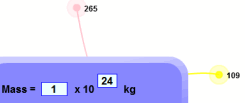STANDARD NUMBERS SIMPLIFIED;
Scientific Notation (also called Standard Form in Britain) is a special way of writing numbers:
| Like this: |  | |
| Or this: |  |
It makes it easy to use big and small values.
OK, How Does it Work?
The number is written in two parts:
- Just the digits, with the decimal point placed after the first digit, followed by
- × 10 to a power that puts the decimal point where it should be
(i.e. it shows how many places to move the decimal point).
In this example, 5326.6 is written as 5.3266 × 103,
because 5326.6 = 5.3266 × 1000 = 5.3266 × 103
Try It Yourself
Enter a number and see it in Scientific Notation:
Now try to use Scientific Notation yourself:
Other Ways of Writing It
3.1 × 10^8
We can use the ^ symbol (above the 6 on a keyboard), as it is easy to type.

Calculators often use "E" or "e" like this:
How to Do it
To figure out the power of 10, think "how many places do I move the decimal point?"
| When the number is 10 or greater, the decimal point has to move to the left, and the power of 10 is positive. | |
When the number is smaller than 1, the decimal point has to move to the right, so the power of 10 is negative. |
Check!
After putting the number in Scientific Notation, just check that:
- The "digits" part is between 1 and 10 (it can be 1, but never 10)
- The "power" part shows exactly how many places to move the decimal point
Why Use It?
Because it makes it easier when dealing with very big or very small numbers, which are common in Scientific and Engineering work.
It can also make calculations easier, as in this example:
It is used a lot in Science:
Play With It!Use Scientific Notation |  |
It can also save space! Here is what happens when you double on each square of a chess board:
Values are rounded off, so 53,6870,912 is shown as just 5×108
That last value, shown as 9×1018 is actually 9,223,372,036,854,775,808
Engineering Notation
Engineering Notation is like Scientific Notation, except that we only use powers of ten that are multiples of 3 (such as 103, 10-3, 1012 etc).
Notice that the "digits" part can now be between 1 and 1,000 (it can be 1, but never 1,000).
The advantage is that we can replace the ×10s with Metric Numbers. So we can use standard words (such as thousand or million), prefixes (such as kilo, mega) or the symbol (k, M, etc)













0 Comments